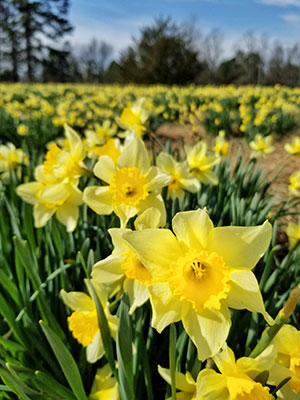As the ice and snow began to disappear, green stalks began to poke sharp points through the soil, soon to be followed by the beautiful yellow daffodil blooms that signal spring. The flower appears in the most unlikely places, its blossoms found everywhere across the state. Wondering in the depths of the National Forest, one can discover patches decorating the ground, usually accompanied by trees that have blossomed into cluster of sweet smelling blossoms. Searching the area, one usually locates the tumbled-down fences, old foundation stones, and sometimes, old cans and bottles left from old homesteads, long ago deserted and forgotten. As plentiful as the daffodil and even the flowering trees appear to be, they are all the product of settlers who brought a piece of their homeland along with them. The daffodil, often called the Easter flower in Arkansas, originated in Spain. Early Roman apothecaries thought the stalk and bulbs had medicinal value so they carried cured specimen along with them as the Roman legions conquered the known world. Planting them at various sites, the hardy flower soon became favorites in gardens throughout Europe and were eventually brought to America. They are celebrated yearly with daffodil festivals in Camden and at old Fort Washington.
Twenty-three percent of all the plants found in Arkansas are non-native, transported in from virtually every country in the world. Even in the midst of dense forest land, three per-cent of the plants you see were not here when the first pioneers arrived.
None of the common fruit trees existed in America but arrived on our shores in much the same way as the daffodil. All of us remember the stories of Johnny Appleseed and how he propagated the growth of America’s favorite fruit. Not all plants brought to America are as enjoyable. Kudzu, brought to the U.S. from Japan over a hundred years ago, has become a nuisance and covers thousands of acres of land in Arkansas. Many homes now grow the Bradford pear. The tree grows fast and has beautiful blossoms in the spring but, it grows so fast that its limbs and branches break off in high winds and ice storms. Our street and road crews probably hate the thought of them after our recent winter weather.
Mimosas dot our yard at home and have been around all my life but were brought here from Japan and Iran in 1745 to be planted as yard ornamentation. They produce so many seed and grow so well in a variety of climates, we find them everywhere.
Nothing is more Arkansas than the flowering honeysuckle. We used to pull the center out of the flower and extract the juice in the center of the flower while enjoying its sweet, sticky smell. Its flowers and vines are found growing up trees, over fences, and climbing the sides of abandoned buildings all over the state. Again, non-native, brought in here from Japan over a century ago.
Around most old home sites you find privet. People use to plant the bush to block off their yards. Left untended, the stuff propagates rapidly into tangled scraggly bushes that take over the land. I have discovered they are virtually impossible to get rid of and, every time I try, I have to attend church to get forgiveness for the unkind thoughts going through my head.
Many of the plants and animals in America arrived here as a part of the collective history and memories of our homeland. Some were brought accidently or as a part of a scientific endeavor that has gone awry. For whatever reason, as we drive through our neighborhoods or wander the paths of our forests, they are a part of life today.







